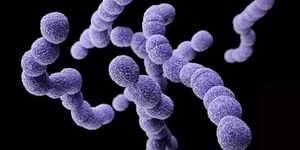No, you can’t catch Alzheimer’s like you could a cold. But
new evidence suggests Alzheimer’s may be transmitted through medical treatments that were contaminated with the prion protein.
In post-mortem analyses of brains of seven people who died from Creutzfeldt–Jakob disease (CJD), researchers found astonishing evidence of amyloid plaques in five of the brains. These pathological protein deposits are one of the distinguishing hallmarks of Alzheimer’s disease.

The seven CJD patients shared another characteristic: years before their death, these patients all received surgical grafts of dura matter – a thick membrane that protects the spinal cord. But the dura grafts were taken from human cadavers that were contaminated with prions. Prions, also known as “proteinaceous infectious particles,” are small proteins that are nearly impossible to destroy, but cause deadly brain-wasting diseases like CJD, mad-cow disease, and kuru.
The researchers hypothesized that contaminated transplanted materials carried prion “seeds” of the amyloid protein, which then propagated and formed the signature amyloid plaques found in brains of Alzheimer’s patients. Support for this theory came when they examined brains of 21 patients who died of CJD but never received the dura transplants. The 21 control brains were devoid of any pathological signs normally associated with Alzheimer’s.
This study is the second one to offer evidence for transmissible Alzheimer. The
first report of this theory was published in September 2015 when researchers found a link between amyloid plaques and patients who died of CJD after exposure to prion-contaminated human growth hormone injections.
In both studies, researchers noted the presence of the amyloid protein clusters were abnormally high, especially given that the patients died at an age not generally associated with so much plaque buildup. John Collinge, co-author of the study published in September 2015, remarked that “In that age group you don’t really see this sort of pathology; it’s only really seen in elderly individuals unless you have a genetic predisposition to it, and none of these patients did.”
“Our results are all consistent,” says Collinge. “The fact that the new study shows the same pathology emerging after a completely different procedure increases our concern.” Doctors don’t use cadaver-derived dura grafts or hormones anymore, but prions can still stick to surgical instruments.
But before we jump to conclusions, lets re-examine some facts. Both studies were conducted on an extremely limited set of data: 7 CJD brains for the 2016 study, and 8 CJD brains for the 2015 study. Combined, they found presence of amyloid clusters in 11 of the CJD brains. While the odds are high, it’s not 100%. Furthermore, no one has reported evidence of the amyloid proteins in the biological preparations that were used in the transplants. And interestingly, there’s lack of evidence that the tau protein – the other half of the “plaques and tangles” of Alzheimer’s – is abnormal in any of the case-study brains.
So, the evidences aren’t conclusive, only suggestive of a transmissible form of Alzheimer’s. The theory has to be further tested in animal studies to truly show cause and effect.
Additional source:
Nature News
 The seven CJD patients shared another characteristic: years before their death, these patients all received surgical grafts of dura matter – a thick membrane that protects the spinal cord. But the dura grafts were taken from human cadavers that were contaminated with prions. Prions, also known as “proteinaceous infectious particles,” are small proteins that are nearly impossible to destroy, but cause deadly brain-wasting diseases like CJD, mad-cow disease, and kuru.
The seven CJD patients shared another characteristic: years before their death, these patients all received surgical grafts of dura matter – a thick membrane that protects the spinal cord. But the dura grafts were taken from human cadavers that were contaminated with prions. Prions, also known as “proteinaceous infectious particles,” are small proteins that are nearly impossible to destroy, but cause deadly brain-wasting diseases like CJD, mad-cow disease, and kuru.







